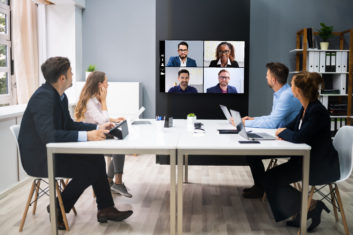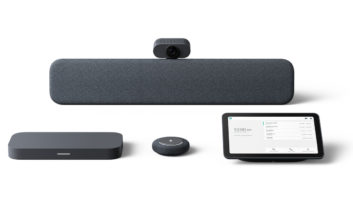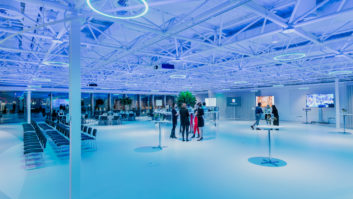The latest edition of Installation – a hybrid workplace special – is available now. Click here to view. You can read our lead feature below.
Even before the global pandemic, there were plenty of indications that hybrid working – whereby employees spent at least part of their time working from home – was on course to become much more commonplace. But as with other developments, such as e-commerce and automation, it’s apparent that Covid-19 has served to greatly accelerate the trend.
 The extent of this shift is laid bare in a recent report, ‘The Future of Work After Covid-19’, produced by McKinsey Global Institute (1). For the first time, the virus “elevated the importance of the physical dimension of work”, including in sectors such as medical and personal care, on-site customer service, and leisure. Conversely, with so many roles able to switch to remote working literally overnight, it also became clear how much work could be done effectively out of the office.
The extent of this shift is laid bare in a recent report, ‘The Future of Work After Covid-19’, produced by McKinsey Global Institute (1). For the first time, the virus “elevated the importance of the physical dimension of work”, including in sectors such as medical and personal care, on-site customer service, and leisure. Conversely, with so many roles able to switch to remote working literally overnight, it also became clear how much work could be done effectively out of the office.
Analysing the potential for remote work to continue after the pandemic, McKinsey assessed more than 2,000 tasks used in 800 occupations across eight focus countries. Considering only work that could be done “without a loss of productivity”, the report concluded that between 20 and 25 of the workforces in advanced economies could work from home between 3 and 5 days per week: “This represents 4 to 5 times more remote work than before the pandemic and could prompt a large change in the geography of work as individuals and companies shift out of large cities into suburbs and small cities.”
PROFOUND SHIFT
Given this profound shift, it’s not surprising that there is much discussion at present regarding the perilous future of commercial property. This is magnified further when, for example, you factor in forthcoming energy efficiency regulations that could render as much as 10% of current London office stock unrentable from 2023 (2).
Hence it’s certain that many companies’ relationship to their physical spaces is going to change profoundly over the next few years – and that has huge implications for AV. Speaking to vendors and installers for this article, it was evident that the main trend is set to be a move away from larger in-person conferencing suites towards more flexible hybrid spaces in which there are almost always remote contributors. Meeting rooms are likely to be used for more specific gatherings, and in ways that make greater requirements of the installed technology. And as much as video is critical, the pandemic has yielded a heightened awareness of the importance of great audio – and how concentration-sapping poor sound can quickly become.
HOT TOPIC
From specialist research, data and consulting company Futuresource, director Chris Mcintyre-Brown confirms that meeting technologies – and the crossover between AV and IT – have become the hot topic. The pandemic, he says, has “forced every company to re-evaluate their AV strategies”, and this is supported by the end-user programmes Futuresource runs in the enterprise space.
“But the more nuanced point is, ‘where does AV stop and IT begin?’,” he continues. “For example, one of the most common questions we come across is ‘where does the role of the personal device (typically mobile PC devices but also phones) end and a dedicated AV solution begin? Investments in a pandemic world have been around UC platforms, or tools of the UC solution, so we have a knowledge-based workforce which has made a huge leap into video but predominantly using IT equipment for communication and increasingly collaborative features. The challenge is to balance this usage, which is already a sunk cost, against the enablement of quality meeting room experiences.”

In particular, there is likely to be a sustained increase in investment in smaller meeting spaces, defined by Futuresource as hosting 1-6 people. “Small meeting rooms, which account for well over 50% of the addressable market, have relatively low penetration of AV technology, and have for some years been the target for the AV industry. The pandemic will be a catalyst for investment in these spaces with SWAPS (software-agnostic peripherals) such as video bars and PTZ cameras, initially demanded to create ‘VC-enabled’ rooms.”
For larger spaces, particularly in major corporations, there is likely to be greater spending on advanced production environments to cope with a more displaced workforce. “And as collaboration and ideation tools become more prevalent, we do expect to see display equipment upgrade,” says Mcintyre-Brown
As well as changes in the technology itself, the requirements of workplace integration will also become more specific – not least for cross-campus, mass-scale deployments, requiring “absolute simplicity in installation and configuration”, and Futuresource sees this becoming an “increasingly hot theme in vendor messages.” Futuresource also sees meeting room monitoring and management, managed services, and ultimately AV as a Service being the “future for this space”.
DIMINISHED DEMAND
Many of these points are echoed by companies active in this space, such as communications technology specialist Macom GmbH. Christian Bozeat, who is UK managing director of Macom, agrees that the demand for large-capacity facilities is likely to be diminished for some time to come. “It’s not surprising, really, as we have all had a bit of a shock and are still coming to terms with a lot of issues to do with people being in close proximity. But with time this will change and there will be a need to interact and be together again. We are human and we like interaction with other humans face to face – not just over video.”
In the meantime, the logistical and practical issues could be just as important as the technological ones. Observing the need to address “how working processes are defined,” Bozeat adds: “Each company needs to invest in understanding what they do, who they interact with and why, and how that interaction is best provided for – and then looking at the technology to meet that business need”.
Whatever the eventual approach taken by individual companies, products that support more flexible planning and monitoring of meeting spaces are going to be critical. Hence Macom’s own development of full monitoring/monitored solutions where “all devices are able to be monitored remotely room-by-room – integrating room booking, AV systems, BMS [building management systems], room occupancy, etc, on a single platform that can be monitored and managed remotely”. This, says Bozeat, allows companies to consolidate their support and save time, money and, importantly, energy across an entire estate wherever it is located.
 Along with the impetus to build workplaces that are more efficient in an organisational sense, it’s probable that many companies will be looking to see how they can boost their efficiency from an environmental standpoint. With major targets advancing Net Zero goals looming in 2030, technology investments will continue to shift towards solutions that help companies reduce their carbon footprints.
Along with the impetus to build workplaces that are more efficient in an organisational sense, it’s probable that many companies will be looking to see how they can boost their efficiency from an environmental standpoint. With major targets advancing Net Zero goals looming in 2030, technology investments will continue to shift towards solutions that help companies reduce their carbon footprints.
Simon Hayes, meeting spaces and collaboration specialist at Sharp NEC Display Solutions, remarks: “As awareness of the environmental crisis increases, buyers are putting the sustainability and environmental compatibility of products high on the agenda when making purchasing decisions. Individuals and companies are actively seeking to do business with organisations which show a genuine commitment to protecting the environment and take their corporate social responsibility seriously.”
Hence a focus on sustainability that means Sharp/NEC uses recycled materials “for all its products”, and avoids hazardous substances. “Our large format displays, at 97.4%, are almost entirely recyclable,” says Hayes. “Helping to reduce energy consumption, many Sharp/NEC displays featured ECO Mode functionality and are equipped with a carbon savings meter for administrating and reporting CO2 reductions.”
It’s no surprise to discover that awareness of maintaining a good supply of fresh air has grown considerably in the wake of Covid. “Currently, air quality is of prime concern in the office space where good ventilation is an important defence against the spread of the virus and, of course, vital for productivity,” continues Hayes. “Smart building strategies using room sensors, or smart displays such as the NEC WD551 Windows Collaboration Display, measure environmental parameters, triggering alerts should air quality fall outside of approved limits. Similarly, sensor technology supports pre-defined room occupancy numbers, alerts cleaning teams between users, and maximises room usage. Centralised monitoring and control of devices on a network will help to proactively manage maintenance requirements, reduce power consumption by automatically powering down at the end of the day, and support more efficient use of resources.”
SOUND IMPORTANCE
Whilst the improvement of video quality has long been an understandable focus of conferencing and communications solutions development, the pandemic has underlined the importance of having crystal-clear audio throughout a call or meeting. Poor or erratic sound, it has become apparent, can be extremely fatiguing, particularly if you are doing multiple remote meetings in a single day.

Amit Ravat, co-founder and director of Lithe Audio, observes that “more and more, companies are thinking about audio and working out what they need to be able to support [the greater variety of meetings they are holding]. In our case, our main products for the office and corporate environment are ceiling speakers which have amplifiers built-in and are super-easy to install.”
Ease of use has always been an important quality of workplace AV, but now Ravat indicates that there will be even more focus on technology’s capabilities as we move from what has previously been a very office-based culture to one in which blended work patterns are much more the norm. “But I still think that offices are going to be a key part of how companies operate, which means they will be looking for solutions [that help optimise the use of their own facilities],” he says.
Alongside better speakers, investment in microphones and acoustical treatments could also be set to rise. Toby Keenan – who handles technical sales and support at London-based AV systems design, consultancy and installation firm Crossover AV – comments: “Acoustic treatment for meeting rooms has become a higher priority where meeting rooms have poor acoustics that affect the quality of VC calls. [Meanwhile] we would certainly argue that investing in good quality microphones, optimally positioned and configured, will make a huge difference to VC call quality. Not all clients are convinced, with some opting for budget solutions that we feel will ultimately be less than satisfactory and need upgrading.”
Jenny Hicks, head of technology at UK AV distributor Midwich, notes that not everyone has access to the same rooms or materials, and all of these things affect the audio experience. “But [general trends] we do see are more people wanting to treat their walls with sonic absorption foam and upgrade their microphones to podcast mics.” She also anticipates a sharp rise in the use of voice control once “the right solutions with the right capabilities [are in place]. When they are I think there will be an evolution from touch solutions to voice control, with touch solutions or non-voice capabilities for those who cannot interact with voice.”
CHALLENGING TIMES
Given the phenomenal change we are already witnessing in the world of work, it’s to be expected that advising companies on their long-term AV strategies will become more challenging. But until such a time when investment cycles become shorter – something that seems distinctly likely – it will be encumbent on consultants and vendors to make solutions as future-proofed as possible.
 Hayes remarks: “Having witnessed the extraordinary changes over the past 18 months or so, 5 to 10 years seems a very long time in tech terms!” Whilst the move towards hybrid working was in progress pre-pandemic, “no one can accurately predict 10 years ahead, but by nurturing long term partnerships with trusted AV-IT suppliers companies can steer their way through their refresh cycles confident that they are investing in long-lasting, future-proofed solutions.” And from a vendor perspective, it remains pivotal, he says, to “work very closely with our solutions partners and the end-user to understand the specific needs of the end-user across all verticals to gain a forward-looking view of trends.”
Hayes remarks: “Having witnessed the extraordinary changes over the past 18 months or so, 5 to 10 years seems a very long time in tech terms!” Whilst the move towards hybrid working was in progress pre-pandemic, “no one can accurately predict 10 years ahead, but by nurturing long term partnerships with trusted AV-IT suppliers companies can steer their way through their refresh cycles confident that they are investing in long-lasting, future-proofed solutions.” And from a vendor perspective, it remains pivotal, he says, to “work very closely with our solutions partners and the end-user to understand the specific needs of the end-user across all verticals to gain a forward-looking view of trends.”
Nonetheless, there are likely to be implications for AV support and maintenance services. Referring to multi-site companies, Bozeat says there will be a need for more fully integrated support systems across all campuses and to further standardise solutions to ensure ease of support. “This will require companies to invest in their internal technology teams – not just the IT team – and develop better processes around the definition design, procurement, delivery and support models,” he opines.
PRIMARY DELIVERY
More and more, it seems inevitable that cloud-based platforms will be the primary delivery mechanism, especially with the reduced cost of ownership that can accrue over time through software updates. Stijn Ooms, director of product strategy AV and digital workplace Europe at Crestron, comments: “I like to compare it a bit to the rise of electricity. In the beginning, every factory had its own generators, because that was just the way it worked. But gradually, we evolved and today we rely on power plants and the abundancy that comes with it. I see the same happening with the switch from on-premise to the cloud. We didn’t have a choice in the beginning, and on premise absolutely had its benefits, but those are now being outshined. The cloud offers massive processing power and built-in security. For a lot of companies, the security through cloud is a lot more extensive than their own network.”
Crestron itself has the XiO Cloud, an IoT-based platform that enables users to remotely provision, monitor and manage devices across an enterprise or an entire client base. “XiO Cloud services facilitate daily management and monitoring of every device through a single dashboard with comprehensive reporting and logging, live status viewing and alerts, performance metrics and analytics, scheduled actions and updates, people counting, and more. As requirements grow and evolve, new features and functionality can be added easily to one or many devices at any time without ever going on-site.”
SKY’S THE LIMIT
As more than one interviewee observed, “the sky’s the limit” when it comes to new technology and its transformative potential in the workplace. But however the future pans out, it’s by continually deepening our understanding of the workplace and its relationship to technology – not least through AI-driven data – that we stand to optimise its usage as work patterns evolve.
 Ooms says that the pandemic showed how useful data can be. “Companies use artificial intelligence on the collected big data. For instance, instead of just knowing that a room is booked, they know if it was actually used, by how many people, what technology, etc. Releasing AI on the collected data allows companies to make a correct decision when deciding on an investment, instead of simply following their gut. Soon we will also have the technology available that could even help predict issues before they arise, [providing information to] the IT/AV team that can prevent or solve them before they are an inconvenience.”
Ooms says that the pandemic showed how useful data can be. “Companies use artificial intelligence on the collected big data. For instance, instead of just knowing that a room is booked, they know if it was actually used, by how many people, what technology, etc. Releasing AI on the collected data allows companies to make a correct decision when deciding on an investment, instead of simply following their gut. Soon we will also have the technology available that could even help predict issues before they arise, [providing information to] the IT/AV team that can prevent or solve them before they are an inconvenience.”
Ultimately, all new technology must be in the service of the company and its personnel. Describing the incoming “activity-based” workplace era, Hicks says that priority must be given to “giving people a reason to come into the office – something that is more than they can get working at home. And increasingly it’s apparent that using technology as part of well thought-out workplaces is a great way of getting people into the office and making that whole aspect worthwhile.”
Sources:
(1) https://www.mckinsey.com/featured-insights/future-of-work/the-future-of-work-after-covid-19
(2) https://www.cnbc.com/2021/08/16/10percent-london-offices-at-risk-of-becoming-obsolete-under-new-energy-rules.html







